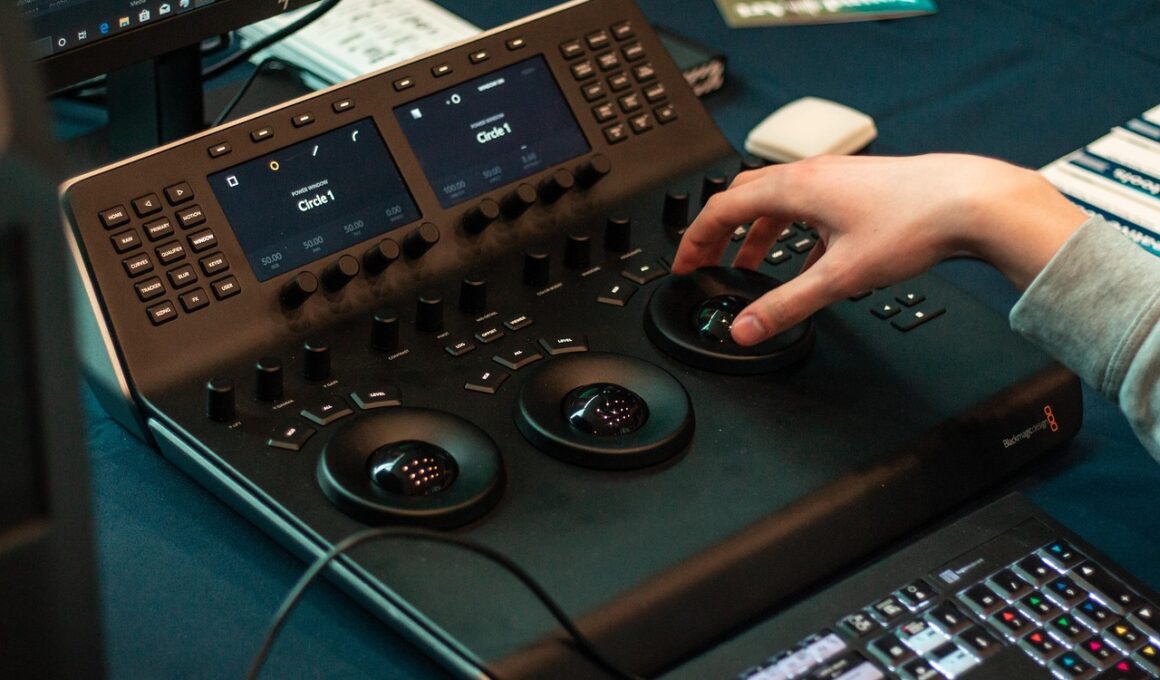Advanced Color Grading Techniques for Professional YouTube Content
Creating visually stunning videos on YouTube often hinges on effective color grading techniques. For many creators, mastering color grading is essential to elevate their content, engage viewers, and articulate storytelling. An understanding of color theory provides a solid foundation for this essential process, enabling creators to make informed decisions. Color grading can dramatically change the mood of a scene, thus influencing how it is perceived by viewers. When color grading, focus on achieving consistency in shades across all shots. This entails matching colors to ensure a cohesive look throughout the content. Additionally, software tools like DaVinci Resolve or Adobe Premiere Pro offer powerful features that allow precision in color adjustments. By using scopes such as vectorscopes and waveforms, creators can assess color accuracy effectively. Techniques such as primary and secondary color corrections can ensure that the skin tones look natural while emphasizing specific colors in a scene. Furthermore, LUTs (Look-Up Tables) can serve as helpful starting points for filmmakers, helping to create a desired atmosphere or mood for the content.
Beyond basic adjustments, utilizing advanced techniques like film emulation can greatly enhance the production quality of YouTube videos. Film emulation allows creators to replicate the look of classic filmstock, adding an organic feel to digital content. This transformation can make an ordinary video feel nostalgic and rich, evoking emotions in viewers. To apply film emulation effectively, experiment with different LUTs designed for specific film types, from Kodak to Fuji stocks. It is also crucial to understand how grain and contrast contribute to the overall feel of a video. Adjusting these elements can guide viewer perceptions and enhance storytelling. Moreover, consider the light sources within your scenes; balancing warm and cool tones can add depth and interest to your shots. Complementing this, leveraging HDR (High Dynamic Range) techniques ensures brighter highlights and darker shadows. This balance enhances the visual impact, especially in action sequences or vibrant, dynamic environments. As you refine your color grading processes, remember that each element speaks to your audience and can transform how they experience your videos.
Understanding Color Wheels and Adjustments
Incorporating color wheels into your grading workflow can yield remarkable results and offers flexibility. Each segment of the color wheel represents different hues, allowing for precise adjustments to shadows, midtones, and highlights. This visual representation helps to create targeted looks that align with your vision. Adjusting these parameters enables colorists to enhance or suppress colors that help tell a story effectively. Further, understanding the interaction between colors helps prevent clashing hues that detract from your message. Color grading isn’t just an afterthought; it’s a foundational aspect of video production. Advanced color grading techniques incorporate tools like split toning and selective color adjustments. Split toning can accentuate the mood by applying distinct colors to the highlights and shadows. Meanwhile, selective adjustments allow detailed modifications to specific colors without disrupting the overall palette. Employ tools that let you tweak these hues actively. Each adjustment should contribute to your narrative and aesthetic goals. With practice, these advanced techniques can blend cohesively, leading to striking visuals that resonate with your audience.
Another aspect of advanced color grading is the implementation of contrast and exposure management. Understanding the importance of contrast will significantly enhance the visual depth of your content. High contrast can intensify drama and highlight critical elements, while lower contrast can create softness and emotional nuances. Be cautious, however; excessive contrast can lead to a loss of detail in shadows and highlights. Achieving the right balance is key to a polished finish. During recording, consider exposure levels to ensure adequate light capture, as proper lighting conditions can simplify post-processing. Use tools like histograms to monitor exposure levels and clarify whether your footage is too dark or light. Additionally, the incorporation of color grading masks can create dynamic compositions that guide the viewer’s eye. You can selectively manipulate sections of a frame, emphasizing elements that require focus. The versatility of masks allows for nuanced storytelling, enhancing scenes that may otherwise go unnoticed. As you explore these techniques, remember to maintain a harmonious palette consistent with your brand’s visual identity and audience expectations.
The Role of Color Grading in Storytelling
In the landscape of video content creation, color grading extends beyond mere aesthetics, playing a pivotal role in storytelling. Colors carry emotional weight; they evoke feelings of happiness, sadness, tension, or nostalgia. As a content creator, effectively using color can lead viewers through an emotional journey aligned with the narrative. By setting up warm tones in scenes depicting comfort and safety, or cooler tones for tension, the environment shapes perceptions significantly. This journey is crafted through thoughtful planning at every production stage. Additionally, establishing color hierarchies can help dictate a viewer’s focus. Colors like bright red or yellow can quickly draw attention, making them crucial for key elements in scenes. Implementing these strategies involves considering the character arcs represented through color shifts as the story progresses. For example, a character’s transformation could be mirrored through color changes, signaling growth or decline. To enhance these aspects, employ stylistic decisions that align with the story’s pacing, ensuring the color grading contributes to the overall narrative rather than distracting from it.
Another crucial technique involves the integration of secondary color grading to target specific areas and elements within the frame. This functionality allows creators to isolate particular colors or ranges, enhancing them without affecting the overall composition. This precision can be particularly useful in highlighting a subject or product, ensuring it stands out from the background. Understanding how to utilize secondary grading effectively is essential for achieving professional-quality results. For instance, if a product’s branding is a specific color, enhancing that color can vastly improve merchandising aspects. Furthermore, consider applying power windows, which allow selective grading of areas, adding dramatic directionality to scenes. This tool is particularly effective in storytelling as it can guide the viewer’s eyes toward crucial elements. Coupling these techniques with your unique style can develop a sophisticated visual language. Always remember to balance these adjustments, maintaining a natural look. A well-composed scene where the subject is distinct but harmoniously integrated into the rest of the frame often yields the most impactful results in terms of viewer engagement.
Final Thoughts on Color Grading Techniques
As you conclude your journey into advanced color grading for YouTube content, remember that mastering these skills takes dedication and practice. Each technique discussed here contributes uniquely to creating impactful videos that resonate with audiences. Incorporating tools and nuances, such as film emulation and secondary color grading, elevates your content to professional standards. Engaging with a community of creators allows you to learn and share insights continuously. Experimenting with your stylistic preferences will further enhance your unique voice in content creation. Don’t hesitate to push the boundaries of creativity, using color as a narrative device that profoundly impacts your storytelling. Always stay updated with the latest trends and technologies in color grading software. Many video editing platforms provide ongoing tutorials, forums, and resources to expand your knowledge and skills over time. In the ever-evolving landscape of digital content creation, leveraging color grading as a tool can set you apart as a professional creator. Ultimately, through practice and experimentation, you’ll develop a keen eye for detail and an extraordinary capacity to captivate audiences with rich, well-graded visuals.
By integrating these color grading techniques, you will undoubtedly enhance the overall aesthetic of your YouTube content. When striving for professional quality, pay close attention to the nuances in each video frame. Color should enhance, not distract, ensuring your message is both clear and visually appealing. Striving for excellence in your video endeavors ensures your viewers are not only engaged but are also inspired by the visual storytelling. Remember that every adjustment should be intentional, contributing to the narrative you want to convey. As the digital landscape continues to evolve, developing a personal style, coupled with these techniques, will ensure your content remains relevant and impactful. Consistently pushing yourself to explore new creative possibilities leads to a more profound connection with your audience. In addition, being part of a creative community allows for support and inspiration. Engage with tutorials and workshops to refine your skills further. Ultimately, your command of color grading will enhance the artistry of your YouTube content and take your storytelling to the next level. By continuing to improve these skills, you ensure your videos are not just watched but also felt.


